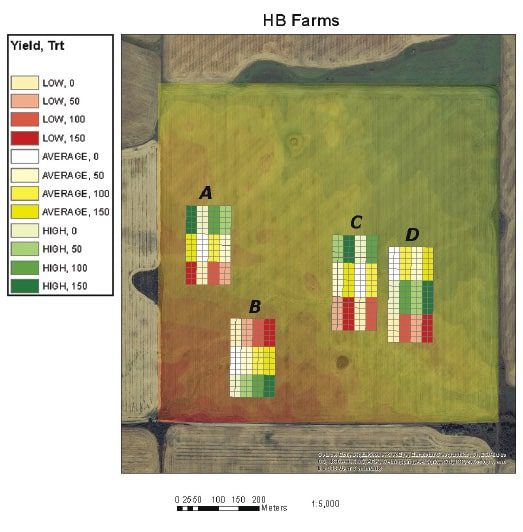Success of VR nitrogen requires field-by-field analysis
Key result: Differences in management, including agronomic practices, variety selection and types of fertilizer, as well as soil properties, elevation and terrain attributes all impact fertility and should be considered, along with historical yields, when planning out a variable-rate (VR) fertility program.
Project title, Principal investigator: “Variable nitrogen fertility management of canola at the field scale,” Alan Moulin, Agriculture and Agri-Food Canada, Brandon
Funding: Growing Forward 2
This project examined several impacts of variable rate nitrogen fertility programs (nitrogen fertilizer rates of 0, 50, 100 and 150 per cent of soil test recommendations) on canola yield in areas with consistently low, average and high production. Data are from 25 sites over four growing seasons in Manitoba, Saskatchewan and Alberta. Investigating variable rate programs proved to be very complex in many ways and a challenge to analyze, but resulting in many types of findings and suggestions for farmers and future research.
Significant improvements in yield were found when comparing plots given nitrogen fertilizer applications versus plots given no nitrogen applications, but not between different fertilizer rates. This is partially due to the variability correlated to terrain and correlations ranging from farm to farm. This emphasized the need for soil tests to account for mineralizable nitrogen, which they currently don’t. Moulin hypothesized that mineralizable nitrogen builds up in the soil following rotations (ex. cereal-canola) and annual nitrogen fertilizer applications, and is available to the crop during the growing season, but is not accounted for in soil test analyses. In contrast to 2014, 2015 and 2016, dry conditions during summer 2017, preceded by ample spring soil moisture, forced crops to root deeper than normal. As a result canola accessed Nitrogen which accumulated normally below the root zone in previous years, and yield was similar for all fertilizer treatments in several fields. Furthermore, yield response may also be attributed to a buildup of mineralizable Nitrogen in or below the root zone. It is possible that mineralizable Nitrogen and the distribution of Nitrogen below the root zone resulted in high production in the control treatments, but updated statistical analysis will provide more insight into this.
Phosphorus was applied with seed at the maximum possible rate, while potassium and sulphur were judged sufficient based on soil test and fertilizer rates used by producers. Soil test phosphorous varied with terrain attributes, which accounted for a significant proportion of the variability of canola yield, but (again) varied from farm to farm. The phosphorus tended to accumulate in lower slope positions, in areas with low production. Soil properties and the interaction with canola variety, growing season precipitation and temperature also varied considerably with respect to yield.
The economic return and efficiency of fertilizer use from variable rate management varied between fields and between farms, as did canola yield. While canola production and net revenue functions generally followed conventional response curves, the effects of zones and nitrogen rates at each individual site were mixed. Overall, nitrogen and production zones were significant with the high production zones generating a net $67 more per hectare, on average, and low production zones generating a net $61 less per hectare compared to average zones. Farm location had significant effects on canola yield, with profitability ranging from negative $490 to positive $530 per hectare.

Overall, the integration of an effective variable rate fertility program is very complicated so carrying out field by field analysis is paramount to potential success. Differences in management, including agronomic practices, variety selection and types of fertilizer, as well as soil properties, elevation and terrain attributes all impact fertility and should be considered, along with historical yields, when planning out a variable rate fertility program or studying fields that do utilize this technology.
Future studies on this topic may benefit from including UAV data (to show fertilizer variability response through in-season images), machine learning methods to create prescription maps (as the analyses relate a large number of variables to potential canola yield) and significant expertise with prescription mapping software (as well as testing the prescription map for the seeder 1-2 days prior to seeding). Thorough preparations well in advance of seeding, combined with post-harvest or pre-seeding soil sampling are recommended to ensure accuracy when carried out at busy times (especially in regions with short growing seasons).





